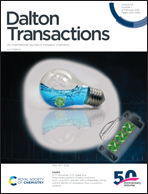Synthesis, crystal structures and magnetic properties of a P-stereogenic ortho-(4-amino-tempo)phosphinic amide radical and its CuII complex†
Abstract
The synthesis of phosphinic amides containing one 4-amino-TEMPO substituent at the ortho position has been achieved through copper(I) catalyzed cross-coupling reactions of ortho-iodophosphinic amides with 4-amino-TEMPO. The method has been extended to the preparation of the first example of a P-stereogenic ortho-(4-amino-tempo)phosphinic amide radical 10. The reaction of 10 with Cu(hfac)2 afforded the P-stereogenic CuII complex 19. The crystal structure of both chiral compounds is reported. The molecular structure of 10 consists of a supramolecular zig-zag chain formed by intermolecular hydrogen bonds between the NH group of the phosphinic amide moiety and the nitroxide oxygen atom. In complex 19, the ligand acts as a bridge between two CuII ions coordinated to the oxygen atoms of the P![[double bond, length as m-dash]](https://www.rsc.org/images/entities/char_e001.gif) O and N–O· groups leading to the formation of a polymeric helicate chain in which the metal ions exist in a distorted octahedral geometry. The magnetic behavior of ligand 10 is characterized by very weak intermolecular antiferromagnetic interactions, whereas ferro- and anti-ferromagnetic interactions are present in complex 19.
O and N–O· groups leading to the formation of a polymeric helicate chain in which the metal ions exist in a distorted octahedral geometry. The magnetic behavior of ligand 10 is characterized by very weak intermolecular antiferromagnetic interactions, whereas ferro- and anti-ferromagnetic interactions are present in complex 19.



 Please wait while we load your content...
Please wait while we load your content...